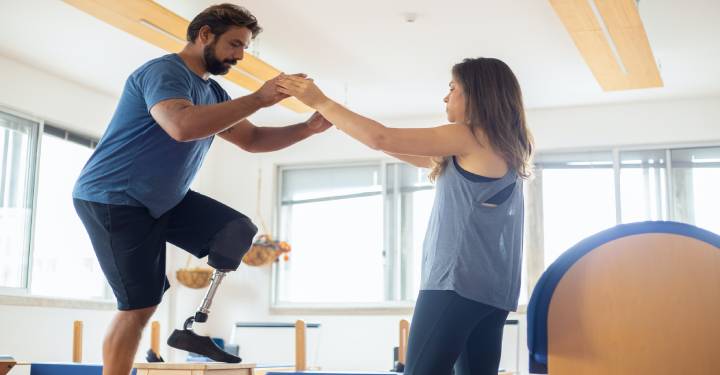How to become a physical therapist assistant

Physical therapy is all about improving and maintaining one’s physical mobility. People go to see PTs for many reasons, like needing help recovering from an injury or managing a disability. But none of it would be possible without the work done by physical therapist assistants, and there’s rarely been a better time to become a PTA.
The U.S. Bureau of Labor Statistics (BLS) predicts that physical therapist assistants will be one of the top 20 fastest-growing professions through 2031.
Many reasons could account for this. In particular, as with other areas of healthcare, is that as older generations age, the need for care increases. Additionally, as average life expectancy increases, the duration of care increases with it, meaning that more people will require the services of PTs and PTAs for longer periods of time.
What is a PTA?
Physical Therapy Assistants provide treatment to patients under the direction and supervision of a Physical Therapist. They implement the treatment plan drawn up by the physical therapist and work hands-on with patients to reach their fitness goals.
Physical therapist assistants vs. physical therapist aides
PT assistants are sometimes confused with PT aides. Both of these jobs work together with physical therapists, however, assistants work with and treat patients directly. Aides, on the other hand, support patients more indirectly.
Aides often prepare treatment areas, move patients and perform clerical duties. Because of this, PT aides typically only need a high school diploma while PT assistants require an associate degree.
How to become a physical therapy assistant in 4 steps
Determine if being a physical therapist assistant is right for you

If you are interested in a healthcare career where you get to work hands-on with patients, physical therapy assisting could be a great fit. When considering whether to become a PTA or a physical therapist, consider the commitment to education you are willing to make—PTs need to earn a doctorate, but assistants need only an associate degree.
Apply to a CAPTE-accredited physical therapist assistant program

Assistants need at least an associate degree from a Physical Therapist Assistant (PTA) program to obtain licensure. Most PTA programs can be completed in two years. These programs must be accredited by the Commission on Accreditation in Physical Therapy Education (CAPTE).
Finish your PTA degree and take the National Physical Therapy Examination (NPTE)

Most PTA programs consist of a combination of classroom and laboratory courses and often require a clinical experience in a healthcare facility to graduate. After you complete your degree or as you are finishing it, you will be eligible to take the NPTE. You must pass this exam to apply for a physical therapist assistant license.
Apply for a physical therapist assistant license

Now that you have your degree and have passed the NPTE, you are most likely eligible to apply for your license to practice as a PTA. Check your state’s licensure requirements to find out if there’s anything else needed to apply for a license in your state.
Find a job as a physical therapist assistant

What does a physical therapist assistant do?
Physical therapist assistants work with patients of all ages and abilities, from infants to the elderly. They improve patients’ quality of life and help them lead more active lives. Assistants execute the treatment plan created by a supervising physical therapist.
Physical therapist assistant job description
They work hands-on with patients to reach their fitness goals. Common goals can include:
In order to achieve these goals, assistants may help patients by doing the following:
What being a PTA is really like (according to an expert)
“In general we would come in, gather a list of patients, and follow the plan of care that’s established by the supervising physical therapist,” said Destini Jammeh, PTA and a member of the Washington State Board of Physical Therapy.
“That can involve therapeutic exercise, therapeutic activity, gait training, range of motion, strengthening, balance, neurological reeducation, wound care, massage therapy, modalities such as traction or ultrasound or electrical stimulation—it just depends on the needs of the individual patient.”
You’re not just helping people go through the motions, though—you’re also working with real people who are unwell, and who may need some emotional support to get better.
“The work is demanding but it is rewarding,” Jammeh said. “It might be a high school girl who hurt herself playing volleyball, or it’s a middle schooler who hurt their rotator cuff playing baseball, or it could be someone’s grandma who had a knee replacement, but you have to understand that you don’t necessarily see people at their best. Sometimes when they’re not encouraged or enthusiastic, you kind of have to put them on your back, so to speak, and get them to where they want to be.”
Where do physical therapist assistants work?
Physical therapist assistants work in a variety of healthcare settings. According to the BLS, the largest employers of PTA’s are:
| Industry | Employment | Percent of industry employment |
|---|---|---|
| Offices of Other Health Practitioners | 41,370 | 4.58% |
| General Medical and Surgical Hospitals | 19,330 | 0.35% |
| Nursing Care Facilities (Skilled Nursing Facilities) | 9,190 | 0.60% |
| Home Health Care Services | 8,770 | 0.59% |
| Offices of Physicians | 5,050 | 0.19% |
And the BLS cites the following metropolitan areas as being the largest employers of PT assistants:
Jammeh works in an outpatient oncology clinic at a hospital in Tacoma, Washington, and enjoys the diversity of working as a PTA in a hospital.
“I like variety. I’m mainly in outpatient but if I have a patient cancellation, I can go upstairs to the hospital and I can see patients in acute or intensive care on the floor,” she said.
Education requirements
All states require that physical therapist assistants have a PTA degree from a CAPTE-accredited program. Obtaining a physical therapy assistant degree is necessary to take the National Physical Therapy Examination (NPTE), which will grant you your PTA license once you’ve passed.
What degree does a physical therapist assistant need?
Bachelor’s degrees for PTA programs do exist, however, only an associate PTA degree is necessary to sit for the NPTE.
Physical therapy assistant bachelor’s degrees are intended for assistants that have already graduated from an associate degree program and who wish to advance their skills. Assistants that enroll in these programs may also be preparing themselves for a graduate degree to transition to becoming a physical therapist.
People that have not already received any physical therapist assistant education should begin with an accredited associate degree program.
What will I need to get into a PTA program?
Like other specialized degrees, many PTA associate degree programs require that you are first admitted to the school and then complete certain prerequisites prior to applying to the actual program.
These prerequisite courses could be any combination of relevant subjects such as biology, anatomy and physiology, psychology, English, communications, math, and more. Some schools even require that applicants spend a certain number of hours job shadowing to apply.
What can I expect to study in PTA school?
Once you have been admitted into the physical therapy assistant program, you will likely take a combination of classroom and laboratory courses. Many programs also have students work in a clinical setting as part of their graduation requirements. Some of the advanced physical therapy assistant courses you may take as a student include:
In most cases, you will be eligible to take the National Physical Therapy Examination for assistants once you are a graduate of or are graduating from your PTA program. It is important to check the requirements by state to see if there is anything else you need to do before taking the test.
Once you pass the NPTE, you will be granted your physical therapist assistant license. As a healthcare professional, most jobs will ask that you earn a CPR and first aid certification as well.
How long does it take to become a PT assistant?
Physical therapist assistant programs can be completed in as little as 18 months, however, between prerequisite courses and clinicals, most will take two years to complete. Your PTA degree length will vary depending on whether you study full-time or part-time, and the specific requirements of your school.
Are online PTA programs available?
There are many PTA programs that offer degrees in online, hybrid, and in-person formats. An online PTA program or hybrid learning model may be ideal for students who have other obligations and require more flexibility with their schedules.
Keep in mind that most PTA online programs will require some sort of in-person clinical experience to graduate, even if they are mostly digital. The most important thing to look for is that the program is CAPTE-accredited.
Do I need to be a PTA first to be a PT?
The short answer is no.
Being a physical therapist assistant is not the first step to becoming a physical therapist. Can a PTA become a PT? Yes, but most assistants stick with their career choice: only about 10% of assistants decide to pursue becoming a physical therapist, according to APTA. The profession should be considered separate from physical therapists even though they work closely together.
The education requirements for physical therapists differ greatly from assistants, so the transition from assistant to physical therapist is not as straightforward as it might appear.
If you are considering whether you want to be a physical therapist or a physical therapist assistant, Jammeh suggests that you consider the level of training you’re willing to undergo.
“Once upon a time, becoming a physical therapist was just a bachelor’s degree, and now it’s a doctorate program. So that has an expense, time, and commitment, so that’s one thing to consider,” she said.
Physical therapy assistant salary
Your exact annual salary as a PT Assistant will vary depending on your location, your particular work environment, and your experience. Developing a good relationship with the physical therapists you work with and making positive connections with your patients, coupled with gaining more experience over time, are good ways to increase your earning potential as a PTA.
PT Assistant salary figures compared by state
Below is the median annual salary for a PTA, the different percentiles, and projected job growth—as well as a state-by-state median salary comparison.
Related: Does the extra education pay off? See how a PTA salary compares to the median salary of a physical therapist.
Where do PTA’s get paid the most?
Comparing PTA salaries by metropolitan area can often give a more precise picture of where exactly PTA’s make the most money. Because it’s one thing to know how much physical therapist assistants make on average across the nation, but it’s more valuable to know how much you can make as a PTA in a given city.
These metropolitan areas have the highest earning potential for physical therapist assistants in the country:
Parting words
Being a PTA can be rewarding, both financially and in terms of personal job satisfaction. You are now better equipped for the journey, with:
- the steps you need to take to become a PTA,
- the education you’ll need,
- duties you can expect to be performing,
- and how much you’ll potentially be making as a PTA once employed.
The only thing left is to find a PTA school, and don’t forget to have fun along the way.

Written and reported by:
Kendall Upton
Staff Writer

With professional insight from:
Destini Jammeh
Physical Therapist Assistant, Washington State Board of Physical Therapy
